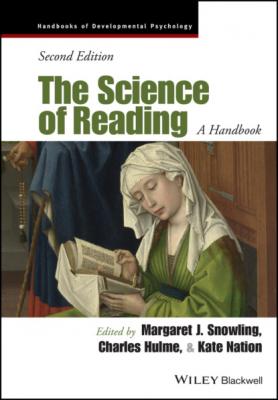The Science of Reading. Группа авторов
Чтение книги онлайн.
Читать онлайн книгу The Science of Reading - Группа авторов страница 53
 style="font-size:15px;"> 26 Friesen, D. C., & Jared, D. (2012). Cross‐language phonological activation of meaning: Evidence from category verification. Bilingualism: Language and Cognition, 15(1), 145–156. doi: 10.1017/S1366728910000489.
style="font-size:15px;"> 26 Friesen, D. C., & Jared, D. (2012). Cross‐language phonological activation of meaning: Evidence from category verification. Bilingualism: Language and Cognition, 15(1), 145–156. doi: 10.1017/S1366728910000489.27 Friesen, D. C., Whitford, V., Titone, D., & Jared, D. (2020). The impact of individual differences on cross‐language activation of meaning by phonology. Bilingualism: Language and Cognition, 23(2), 323–343. doi: 10.1017/S1366728919000142.
28 Frost, R. (1998). Toward a strong phonological theory of visual word recognition: True issues and false trails. Psychological Bulletin, 123(1), 71–99. doi: 10.1037/0033‐2909.123.1.71.
29 Frost, R., Katz, L., & Bentin, S. (1987). Strategies for visual word recognition and orthographic depth: A multilingual comparison. Journal of Experimental Psychology: Human Perception and Performance, 13(1), 104–115. doi: 10.1037//0096‐1523.13.1.104.
30 Galletly, S. A., & Knight, B. A. (2004). The high cost of orthographic disadvantage. Australian Journal of Learning Difficulties, 9(4), 4–11. doi: 10.1080/19404150409546774.
31 Gerrits, R., Van der Haegen, L., Brysbaert, M., & Vingerhoets, G. (2019). Laterality for recognizing written words and faces in the fusiform gyrus covaries with language dominance. Cortex, 117, 196–204. doi: 10.1016/j.cortex.2019.03.010.
32 Glushko, R. J. (1979). The organization and activation of orthographic knowledge in reading aloud. Journal of experimental psychology: Human perception and performance, 5(4), 674–691. doi: 10.1037/0096‐1523.5.4.674.
33 Gollan, T. H., Forster, K. I., & Frost, R. (1997). Translation priming with different scripts: Masked priming with cognates and noncognates in Hebrew‐English bilinguals. Journal of Experimental Psychology: Learning, Memory and Cognition, 23, 1122–1139. doi: 10.1037//0278‐7393.23.5.1122.
34 Grainger, J. Kiyonaga, K., & Holcomb, P.J. (2006). The time‐course of orthographic and phonological code activation. Psychological Science, 17, 1021–1026. doi: 10.1111/j.1467‐9280.2006.01821.x.
35 Hanley, R., Masterson, J., Spencer, L., & Evans, D. (2004). How long do the advantages of learning to read a transparent orthography last? An investigation of the reading skills and reading impairment of Welsh children at 10 years of age. The Quarterly Journal of Experimental Psychology Section A, 57(8), 1393–1410. doi: 10.1080/02724980343000819.
36 Harm, M., & Seidenberg, M.S. (2004). Computing the meanings of words in reading: Division of labor between visual and phonological processes. Psychological Review, 111, 662–720. doi: 10.1037/0033‐295X.111.3.662.
37 Huettig, F., Lachmann, T., Reis, A., & Petersson, K. M. (2018). Distinguishing cause from effect–many deficits associated with developmental dyslexia may be a consequence of reduced and suboptimal reading experience. Language, Cognition and Neuroscience, 33(3), 333–350. doi: 10.1080/23273798.2017.1348528.
38 Huey, E.B. (1908). The psychology and pedagogy of reading. New York: The Macmillan Company.
39 Jouravlev, O., & Jared, D. (2018). Cross‐script orthographic and phonological preview benefits. Quarterly Journal of Experimental Psychology, 71(1), 11–19. doi: 10.1080/17470218.2016.1226906.
40 Keck, T., & Wolgemuth, K. (2020). American Sign Language Phonological Awareness and English Reading Abilities: Continuing to Explore New Relationships. Sign Language Studies, 20(2), 334–354. doi: 10.1353/sls.2020.0004.
41 Kinoshita, S., Gayed, M., & Norris, D. (2018). Orthographic and phonological priming effects in the same–different task. Journal of Experimental Psychology: Human Perception and Performance, 44(11), 1661–1671. doi: 10.1037/xhp0000548.
42 Kuperman, V., Kyröläinen, A.J., Porretta, V., Brysbaert, M., & Yang, S. (2021). A lingering question addressed: Reading rate and most efficient listening rate are highly similar. Journal of Experimental Psychology: Human Perception and Performance, 47(8), 1103–1112. https://doi.org/10.1037/xhp0000932.
43 Lesch, M. F., & Pollatsek, A. (1993). Automatic access of semantic information by phonological codes in visual word recognition. Journal of Experimental Psychology: Learning, Memory, and Cognition, 19(2), 285–294. doi: 10.1037//0278‐7393.19.2.285.
44 Lindgren, S.D., De Renzi, E., Richman, L.C. (1985). Cross‐national comparisons of developmental dyslexia in Italy and the United‐States. Child Development, 56, 1404–1417. doi: 10.2307/1130460.
45 Liu, X., Vermeylen, L., Wisniewski, D., & Brysbaert, M. (2020). The contribution of phonological information to visual word recognition: Evidence from Chinese phonetic radicals. Cortex. Advance publication available at https://doi.org/10.1016/j.cortex.2020.09.010.
46 Lukatela, G., & Turvey, M. T. (1994). Visual access is initially phonological: 1 Evidence from associative priming by words, homophones, and pseudohomophones. Journal of Experimental Psychology: General, 123, 107–128. doi: 10.1037//0096‐3445.123.2.107.
47 Manguel, A. (1996). A History of Reading. HarperCollins.
48 McCutchen, D., & Perfetti, C. A. (1982). The visual tongue‐twister effect: Phonological activation in silent reading. Journal of Verbal Learning and Verbal Behavior, 21(6), 672–687. doi: 10.1016/S0022‐5371(82)90870‐2.
49 Morais, J., Alegría, J., & Content, A. (1987). The relationships between segmental analysis and alphabetic literacy: An interactive view. Cahiers de Psychologie Cognitive, 7(5), 415–438.
50 Nakayama, M., Sears, C. R., Hino, Y., & Lupker, S. J. (2012). Cross‐script phonological priming for Japanese‐English bilinguals: Evidence for integrated phonological representations. Language and Cognitive Processes, 27(10), 1563–1583. doi: 10.1080/01690965.2011.606669.
51 Norris, D., & Kinoshita, S. (2012). Reading through a noisy channel: Why there's nothing special about the perception of orthography. Psychological Review, 119(3), 517–545. doi: 10.1037/a0028450.
52 Patterson, K.E. (1982): The relation between reading and phonological coding: Further neuropsychological observations. In A.W. Ellis (Ed.), Normality and pathology in cognitive functioning (pp. 77–111). London: Academic Press.
53 Pearson, P.D., & Goodin, S. (2010). Silent reading pedagogy: A historical perspective. In E.H. Hiebert & D.R. Reutzel (Eds.), Revisiting silent reading: New directions for teachers and researchers (pp. 3–23). International Reading Association. doi: 10.1598/0833.01.
54 Perea, M., & Carreiras, M. (2006). Do transposed‐letter similarity effects occur at a prelexical phonological level? Quarterly Journal of Experimental Psychology, 59(9), 1600–1613. doi: 10.1080/17470210500298880.
55 Perea, M., & Lupker, S. J. (2003). Does jugde activate COURT? Transposed‐letter similarity effects in masked associative priming. Memory & Cognition, 31(6), 829–841. doi: 10.3758/bf03196438.
56 Perea, M., Nakatani, C., & van Leeuwen, C. (2011). Transposition effects in reading Japanese Kana: Are they orthographic in nature? Memory & Cognition, 39(4), 700–707. doi: 10.3758/s13421‐010‐0052‐1.
57 Perfetti, C. A., & Bell, L. (1991). Phonemic activation during the first 40 ms of word identification: Evidence from backward masking and priming. Journal of Memory and Language, 30(4), 473–485. doi: 10.1016/0749‐596X(91)90017‐E.
58 Perfetti, C., Cao, F., & Booth, J. (2013). Specialization and universals